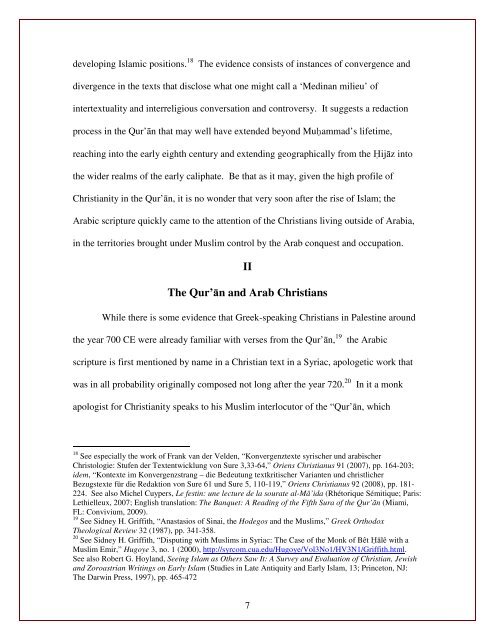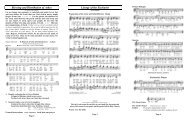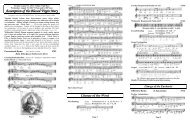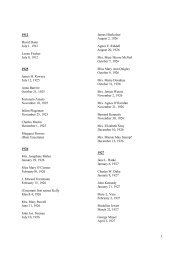The Qur'Än in Christian Thought - Saint Benedict Catholic Church
The Qur'Än in Christian Thought - Saint Benedict Catholic Church
The Qur'Än in Christian Thought - Saint Benedict Catholic Church
Create successful ePaper yourself
Turn your PDF publications into a flip-book with our unique Google optimized e-Paper software.
develop<strong>in</strong>g Islamic positions. 18<strong>The</strong> evidence consists of <strong>in</strong>stances of convergence anddivergence <strong>in</strong> the texts that disclose what one might call a ‘Med<strong>in</strong>an milieu’ of<strong>in</strong>tertextuality and <strong>in</strong>terreligious conversation and controversy. It suggests a redactionprocess <strong>in</strong> the Qur’ān that may well have extended beyond Muammad’s lifetime,reach<strong>in</strong>g <strong>in</strong>to the early eighth century and extend<strong>in</strong>g geographically from the ijāz <strong>in</strong>tothe wider realms of the early caliphate. Be that as it may, given the high profile of<strong>Christian</strong>ity <strong>in</strong> the Qur’ān, it is no wonder that very soon after the rise of Islam; theArabic scripture quickly came to the attention of the <strong>Christian</strong>s liv<strong>in</strong>g outside of Arabia,<strong>in</strong> the territories brought under Muslim control by the Arab conquest and occupation.II<strong>The</strong> Qur’ān and Arab <strong>Christian</strong>sWhile there is some evidence that Greek-speak<strong>in</strong>g <strong>Christian</strong>s <strong>in</strong> Palest<strong>in</strong>e aroundthe year 700 CE were already familiar with verses from the Qur’ān, 19the Arabicscripture is first mentioned by name <strong>in</strong> a <strong>Christian</strong> text <strong>in</strong> a Syriac, apologetic work thatwas <strong>in</strong> all probability orig<strong>in</strong>ally composed not long after the year 720. 20In it a monkapologist for <strong>Christian</strong>ity speaks to his Muslim <strong>in</strong>terlocutor of the “Qur’ān, which18 See especially the work of Frank van der Velden, “Konvergenztexte syrischer und arabischerChristologie: Stufen der Textentwicklung von Sure 3,33-64,” Oriens <strong>Christian</strong>us 91 (2007), pp. 164-203;idem, “Kontexte im Konvergenzstrang – die Bedeutung textkritischer Varianten und christlicherBezugstexte für die Redaktion von Sure 61 und Sure 5, 110-119,” Oriens <strong>Christian</strong>us 92 (2008), pp. 181-224. See also Michel Cuypers, Le fest<strong>in</strong>: une lecture de la sourate al-Mâ’ida (Rhétorique Sémitique; Paris:Lethielleux, 2007; English translation: <strong>The</strong> Banquet: A Read<strong>in</strong>g of the Fifth Sura of the Qur’ān (Miami,FL: Convivium, 2009).19 See Sidney H. Griffith, “Anastasios of S<strong>in</strong>ai, the Hodegos and the Muslims,” Greek Orthodox<strong>The</strong>ological Review 32 (1987), pp. 341-358.20 See Sidney H. Griffith, “Disput<strong>in</strong>g with Muslims <strong>in</strong> Syriac: <strong>The</strong> Case of the Monk of Bêt ālê with aMuslim Emir,” Hugoye 3, no. 1 (2000), http://syrcom.cua.edu/Hugoye/Vol3No1/HV3N1/Griffith.html.See also Robert G. Hoyland, See<strong>in</strong>g Islam as Others Saw It: A Survey and Evaluation of <strong>Christian</strong>, Jewishand Zoroastrian Writ<strong>in</strong>gs on Early Islam (Studies <strong>in</strong> Late Antiquity and Early Islam, 13; Pr<strong>in</strong>ceton, NJ:<strong>The</strong> Darw<strong>in</strong> Press, 1997), pp. 465-4727






